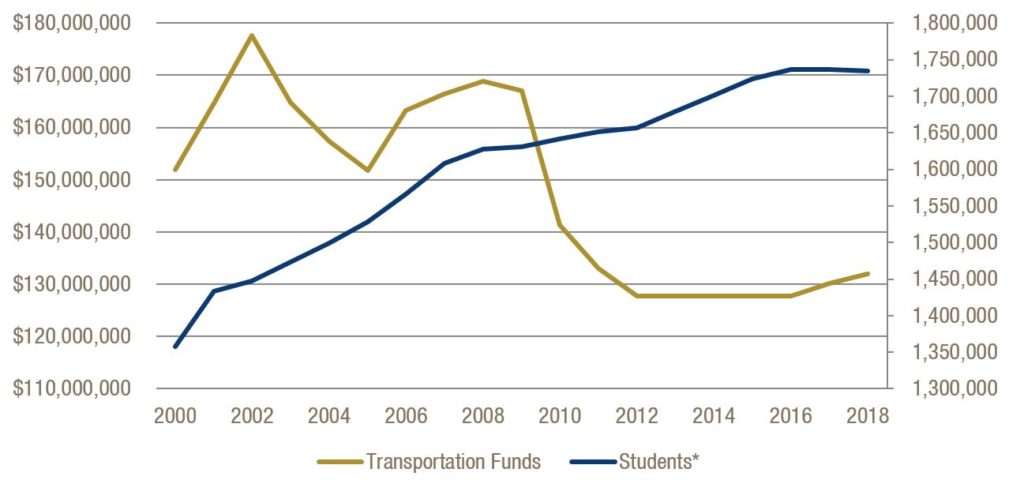Gov. Nathan Deal’s budget proposal for the 2018 fiscal year boosts funding for Georgia’s 1.7 million public school students by $515 million over the current budget for a total of $9.4 billion. The proposal includes a 2 percent salary increase for authorized teachers. At the same time, districts face growing financial pressures. The budget calls for $166 million less than the state’s school funding formula calculates school systems should receive. School districts will need to pay nearly $30 million more for health insurance for bus drivers and other non-teaching staff, and that’s on top of steep price hikes in previous years. Districts will also shoulder a portion of rising retirement costs and offset shrinking state funding for student transportation.
By the Numbers
Amended 2017 Fiscal Year Budget
- Current funding for the Georgia Department of Education is proposed to increase by $111.7 million compared to the 2017 budget the governor signed last spring. More than 76 percent, or $85.5 million, covers student enrollment growth.
- About $9.1 million is new money for the State Commission Charter School supplement to cover growth in existing schools and to establish four new state charter schools.
- Funding for charter systems is proposed to increase nearly $9.5 million.
- The Special Needs Scholarship program is in line to get an additional $6.5 million.
- The department’s Information Technology Services unit is allotted $500,000 for a study on upgrading its decades-old financial technology system.
- The Georgia Public Telecommunications Commission is in line to receive $3.5 million to develop formative assessments in math and reading for students in kindergarten through third grade in collaboration with the department and the Governor’s Office of Student Achievement.
- The proposal calls for the University System of Georgia to receive about $2.4 million to establish the Center for Early Language and Literacy at Georgia College and State University to promote research-based literacy programs for children birth to eight.
- The Georgia Student Finance Commission would get an extra $16.8 million in the amended budget for Move On When Ready, the program that enables high school students to take postsecondary classes.
2018 Fiscal Year Budget
- The budget proposed for fiscal year 2018 adds $515 million, or nearly 5.8 percent, to current state funding for Georgia’s public school students through the Georgia Department of Education.
- A 2 percent salary increase for authorized teachers accounts for $160 million of the new spending.
- About $133 million is to cover expected enrollment growth and routine increases in teacher salaries based on years of experience and training.
- The biggest jump is $177 million intended to cover an increase in the employer share of retirement costs.
- Funding for the Equalization Program, which provides grant to districts with low-property wealth, is targeted for about a $85.9 million increase.
- Districts would pay almost $30 million more to cover an increase in the monthly cost of health insurance for bus drivers and other non-teaching staff.
- Move On When Ready is allocated $29.4 million in the proposal through the Georgia Student Finance Commission to keep pace with anticipated enrollment growth.
- The university system is set to receive $2.7 million for the Center for Early Language and Literacy.
Austerity Cut Continues
The austerity cut now in place remains in the proposed 2018 fiscal year budget. Districts are set to get $166 million less than the amount calculated by the state’s own school funding formula. This threatens to halt the progress made over the last three years to reduce the austerity cut from $1 billion, which was its size each year from 2010 to 2014. Continued underfunding leaves districts short on funds to hire teachers and reduce class sizes, restore programs cut due to slashed budgets, provide coaching or other professional development to teachers, or offer other key supports for students.
Rising Salary and Retirement Costs Squeeze Districts
The proposed budget adds $160 million for a pay raise for authorized teachers. The money is proposed as an addition to the state’s teacher salary schedule, the first update to the schedule since the 2009 fiscal year. The base teacher salary, the amount earned by a first-year teacher with a bachelor’s degree, is set to rise to about $34,100 from $33,424.
The pay bump promises a step forward for teachers but it comes at a price for districts. School systems cover the full cost of Social Security and Medicare taxes on teachers’ salaries and will pay about $12 million more if the salary increase is adopted as proposed.
Many districts have teachers who are not “authorized” under the funding formula so their base salaries are not covered by the state. The formula determines the number of authorized teachers in a school district based on the ratio of students to teachers. Districts are set to cover pay raises for non-authorized teachers with local revenue or, if available, other funds to include them in the salary hike.
Districts also face rising retirement costs. The employer share of contributions to the Teacher Retirement System rises from 14.27 percent to 16.81 percent in the proposed 2018 fiscal year budget, the fifth increase since the 2008 fiscal year. The state would cover this hike for the portion of teachers’ salaries it provides. Many districts supplement the state teacher salary schedule to offer competitive wages to attract and retain educators. Those districts pay the employer share of retirement costs on these salary supplements so the rate hike would drive this expense up.
State Shifting Healthcare and Transportation Costs to Districts
Lawmakers continue to shift health care and student transportation costs onto districts. This consumes more local revenue, preventing districts from using these dollars in the classroom, and undermines the reduction in the austerity cut over the last three years.
Health Insurance for Non-Certified Workers
School districts employ bus drivers, custodians, administrative staff and other workers who are not certified to teach. For many years, districts and the state shared the cost of providing these workers health insurance through the State Health Benefit Plan. Georgia began reducing its contribution in 2009 and eliminated it entirely in 2012. Plan administrators increased the monthly amount districts must pay for employees from $218.20 to $846.20 in the 2017 fiscal year, adding over $400 million to districts’ health care costs. The monthly bill for each non-certified worker is set to climb to $946 in the 2018 fiscal year, an increase to districts’ total cost of almost $30 million.
Student Transportation
State funding for student transportation has declined for years. Total funding for busing shrank from about $152 million in the 2000 fiscal year to $131 million in the proposed 2018 budget, a decline of about 13 percent. Student enrollment climbed during this period so the drop in state transportation spending for each full-time equivalent student was even steeper—32 percent, from about $112 per student to $76.
More Students, Fewer State School Bus Dollars

*Full Time Equivalent Student
State funding is well below what districts spend to get students to and from school safely. Districts spent about $825 million on student transportation in the 2016 fiscal year and an average of nearly $475 per student.
Poverty Increases Student Need
About 62 percent of Georgia’s public school students are economically disadvantaged as measured by their participation in the federal free and reduced lunch program. This is the fourth highest percentage in the nation.[1] These students come to school with extra needs that require extra resources. Meeting those needs while coping with the lingering austerity cut and escalating costs presents an ongoing challenge.
[1] U.S. Department of Education. Digest of Education Statistics 2015. Table 204.10 Number and percentage of students eligible for free and reduced-price lunch by state. https://nces.ed.gov/programs/digest/d15/tables/dt15_204.10.asp.








